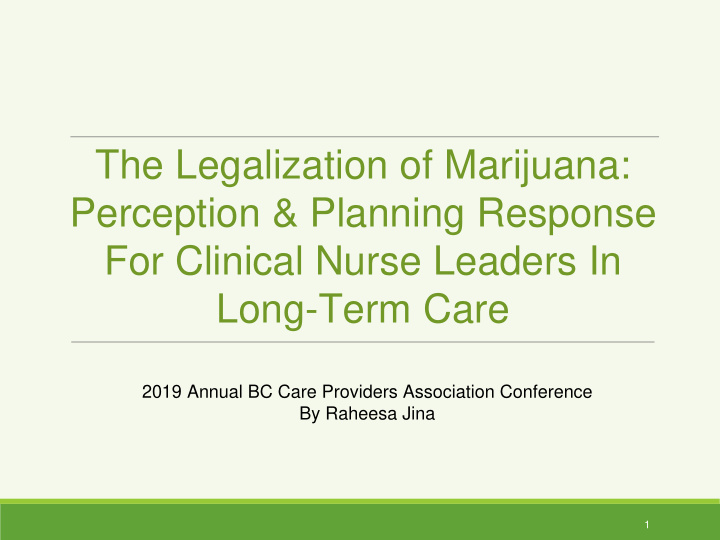



The Legalization of Marijuana: Perception & Planning Response For Clinical Nurse Leaders In Long-Term Care 2019 Annual BC Care Providers Association Conference By Raheesa Jina 1
Background • The Cannabis plant contains over 104 different cannabinoids, the most well-known being tetrahydrocannabinol (ElSohly and Gul; 2014) • Cannabidiol (CBD), a psychoactive non euphoric cannabinoid, has therapeutic properties (National Academics of Sciences, Engineering, and Medicine; 2017) • Canada is the second country to legalize marijuana (Dolgin, 2018) 2
Background • The Cannabis Act came into force in Canada in October 2018 ▪ Individuals 18 and over may possess up to 30 g of cannabis ▪ Distribution is strictly regulated ▪ Not all cannabis is legal (Cannabis Act, 2018) 3
Purpose • Explore the perceptions of nurses in long term care settings regarding the new Cannabis Act • Plan responses for how to help directors of care bridge gaps to meet requirements in the long term care setting 4
Methodology • Used grounded theory approach • Semi structured interview questions were used to conduct 3 focus groups held in Surrey, BC (n=9), Coquitlam, BC (n=12), and Kelowna, BC (n=9) • Interview questions touched on the following: ▪ Understanding of cannabis use in continuing care ▪ Changes in practice post legalization ▪ Nursing concerns ▪ Tools to support nursing practices • Rigorous coding identified the themes in focus group discussions. 5
Demographics • Sex ▪ 6 males (20%) and 24 females (80%) • Role in Long Term Care ▪ 20 Licensed Practical Nurses ▪ 6 registered nurses ▪ 4 other (13%) 6
Results: Emerging Themes • Unfamiliarity • “I know its legal because you see it in news headlines. Medicinal purposes are very clear. But in terms of recreational use there are a lot of questions up in the air, a lot of grey matter that hasn’t been sorted out yet” 7
Results: Emerging Themes • Law/Policy Mismatch • “Our smoke free environment policy only talks about smoking tobacco and does not include marijuana” 8
Results: Emerging Themes • Sensed Inadequacy • “This drug is still a complementary therapy and families need better teaching about the use of this drug, where can I get all the information I need so that I’m educated about this drug and so that I can share my knowledge and answer the questions they have” 9
Results: Emerging Themes • Adverse Effects • “I have [a] lady with dementia that is now self medicating and I am worried about her falling and how this might further impact her cognition” • “Elderly people may have some real risks like drowsiness and dizziness that could contribute to falling and this is worrisome when we already have so many residents at risk for falls” 10
Results: Emerging Themes • Management, Possession, Storage • “In the law, we are just allowed 30 grams of marijuana. How does it look when a police comes and as a nurse I am controlling 30 grams of cannabis for 3 residents? Am I going to be criminally charged for having three times [the legal limit]?” 11
Results: Emerging Themes • Decreased Stigmatization • “Before I just associated marijuana with drugs, a way of getting high. Now I’m more aware it can be used for different purposes...like treating mental health” • “Families are often the biggest advocate for their loved ones, they get lots of information from the internet on all the benefits of marijuana use vs the use of other narcotics” 12
Discussion: How Does This Translate into Supporting Clinical Nurse Leaders • In-service education for the interdisciplinary team specifically front line nurses • Changing existing policies and clarifying protocols so that they are in line with the current legislation • Developing education tools for front line staff to use for educating families and or residents • Clarifying guidelines for dealing with the different forms of marijuana 13
Limitations • Small sample size (n=30) • Voluntary bias, nurses chose to participate • Generalizability to out of province and non Canadian institutions 14
Conclusion • Nurses face barriers in fully understanding and navigating the new legislation • The new cannabis laws have called for a balancing of rights ○ Safely providing access to medical and recreational marijuana ○ Respecting rights, safety, and health of residents, staff, and volunteers within the long-term care setting. 15
16
References 1. Aminian, E., Kirkham, R., Fenn, P. (2013, September). Research design in the context of grounded theory: The role of research philosophical position. Paper presented at the British Academy of Management, Liverpool, UK. 2. Bansal, P., Bertels, S., Ewart, T., MacConnachie, P., O’Brien, J. (2012). Bridging the research – practice gap. The Academy of Management Perspectives, 26(1), 73-92. 3. Birks, M., Mills, J. (2011). Grounded theory: A practical guide (1st ed.). London, England: SAGE 4. Cannabis Act (S.C. 2018, c. 16) [PDF]. (2018, October 17). Ottawa: Minister of Justice. 5. Dolgin, E. (2018). What legal weed in Canada means for science. Nature, 562 (7727), 327-330. 6. Dunne, C. (2011). The place of the literature review in grounded theory research. International Journal of Social Research Methodology , 14, 111-124. 17
References 7. Elsohly, M., Gul, W. (2014). Handbook of Cannabis. Oxford, UK: Oxford University Press. 8. Li, RF., Lu, GT., Li, L., Su, HZ., Feng GF., Chen, Y., He, YQ., Jiang, BL., Tang, DJ., Tang, JL. (2014). Identification of a putative cognate sensor kinase for the two- component response regulator HrpG, a key regulator controlling the expression of the hrp genes in Xanthomonas campestris pv. campestris. Environmental Microbiology, 16(7), 2053-2071. 9. National Academies of Sciences, Engineering, and Medicine. (2017). The Health Effects of Cannabis and Cannabinoids: The Current State of Evidence and Recommendations for Research. Washington, DC: The National Academies Press. 10. Strauss, A., & Corbin, J. (1998). Basics of qualitative research: Grounded theory procedures and techniques (2nd ed.). Newbury Park, CA: Sage. 18
Recommend
More recommend